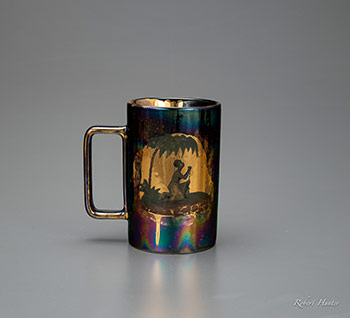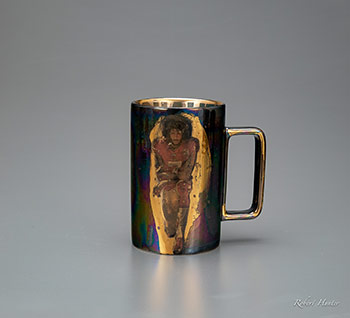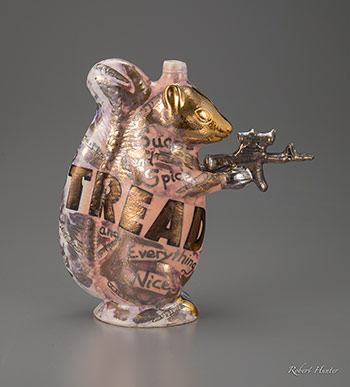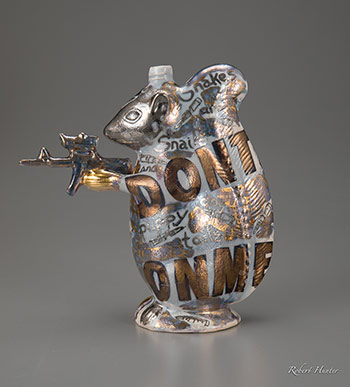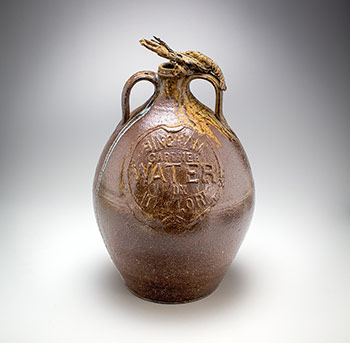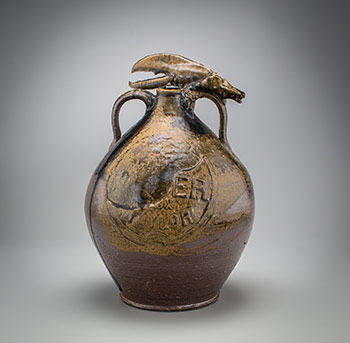ARTIFACTS at Try-me
Artifacts will feature the ceramics of artist Michelle Erickson in the setting of Try-me the private art space that houses The Modern and Contemporary Art Collection of Pamela K. and William A. Royall Jr. The exhibition will be on view March 20-23 in conjunction with NCECA 2024.
Butterfly Skulls
Royall collection
2015
H 8” W 12” D 6”
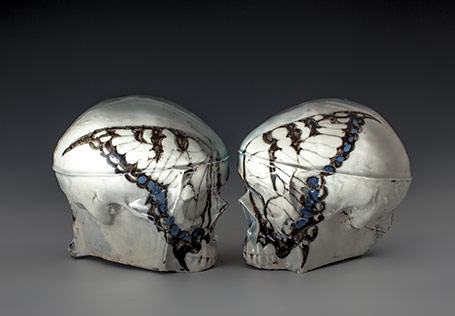 |
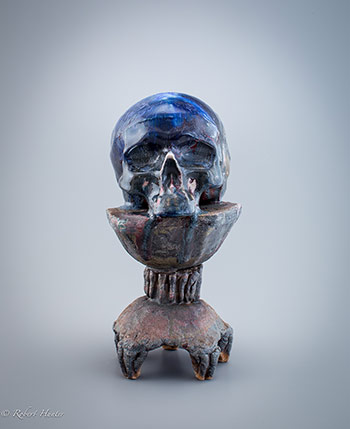 |
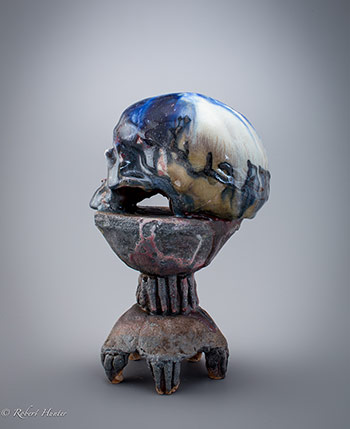 |
| RELIC Price: POR 2015 H 11” Slipcast porcelain, handbuilt indigenous clays and black porcelain slip trailing. High temperature wood fire. I used the porcelain skull in this work to demonstrate glazing during my presentation at the Metropolitan Museum in may 2015. The skull became the subject of Relic: and one work in an ongoing series creating future artifacts that originate in the present an are excavated or kept into an imagined future. The human skull as a representation of the temporal suggests the human cost of conflict and war. Inscribed in black porcelain with Arabic word for liberty and the Hebrew for justice as an ancient outcry from of the endless Israeli Palestinian conflict the OM point for the middle east now ravaged by terrorism. See: Friday Focus—An Artist's Perspective: The Robert A. Ellison Jr. Collection of French Ceramics |
|
Paradise Lost
Royall collection
2008
L 24”
Porcelain, original artwork thrown and hand modeled for molding.
Press molded with added sprig molded elements, underglaze metallic oxide
and overglaze enamel decoration.
* Inciteful Clay 2013-2015
 |
Fossil Teapot
VMFA collection of Modern and Contemporary Art
2008
H 11” L 22”
Thrown and hand modeled, slip cast and press molded porcelain.
This work connects the fascination in the 18th century with the discovery of fossils to our 21st century addiction to fossil fuels and the foreboding idea of a human fossil.
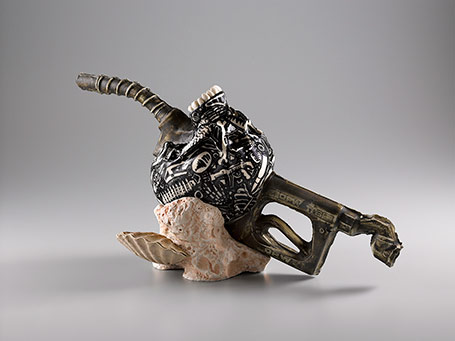 |
Quahog Bottle Another Crossing series
Price: POR
Date 2023
H 7”
Materials: Thrown and handbuilt with life cast Quahog shell. Woodfired indigenous NC stoneware
In the exhibition project Another Crossing curator Glenn Adamson invited myself and 9 other contemporary artists to create work to mark the 400th anniversary of the Mayflower crossing the Atlantic in 1620. The Protestant pilgrimage to escape religious persecution in Britain and Europe landed in Patuxet the ancient home of the Wampanoag people.
“There were many experiences in Plymouth to inform and inspire us as artists, but for me the most striking reality was all around us and under our feet. The majesty of this great North American coastal landscape, it’s rich resource and it’s vulnerability in the 21st century.”
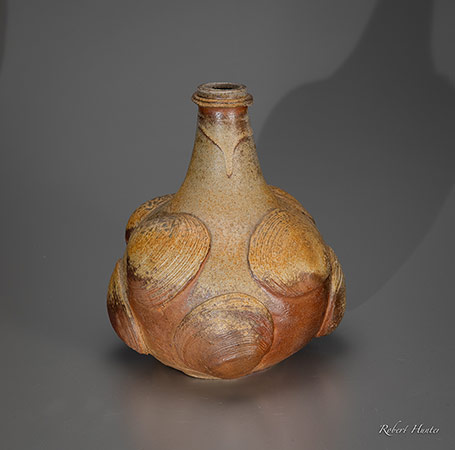 |
Erickson’s works for the exhibition project another crossing combined industrial artifacts of fossil fuel with life cast shell using 17th century methods of forming and woodfiring. The scallop shell of Christian pilgrimage is also the iconographic symbol of Shell Oil and the fossil fuel industry. The quahog shell is the material of Wampum and Wampum is often wrongly reduced to the idea of currency. The quahog covered early English wine bottle form is perhaps symbolic today of social, environmental and economic justice for Native people being inextricably linked to the monetary value of casino rights and the exploitation of their lands natural resources.
G-Jug
Price: POR
Date: 2022
H 8”
Materials: Woodfired stoneware Thrown with 3D printed and cast sprig molds.
Photo: Robert Hunter
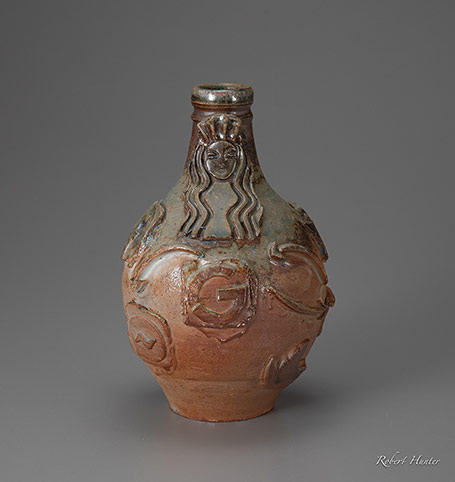 |
G –Jug is a continuation of the ME 2 jug series that incorporates my 3D model print and cast of the Starbucks logo as a bellarmine or bartman mask. The 21st centuries most recognized female icon represents a global commodity transposed to create a modern interpretation to the bellarmine jugs found at virtually every colonial archeology site in the world.
G-jug connects the German bellarmine jugs as artifacts of colonial expansion to 21st century corporate ‘colonialism’ as complicit in the Republican politics of legislating the subjugation of women in America through egregious restrictions on access to abortion. Corporate involvement in the Right Wing political takeover of SCOTUS and eventual overturning of Roe V Wade cannot be overstated. Therefore a woman’s autonomy over her own body- a Woman’s right to her own life has been denied thru political activism that is inextricably linked to the corporate America’s subversive support. The extreme Right Wing politics that advance the undue influence power and wealth of Corporations has specifically cost of Women's lives.
Oil Jug
Price: POR
Date: 2022
H 8”
Materials: Woodfired stoneware Thrown with 3D printed and cast sprig molds.
Photo: Robert Hunter
Oil Jug draws on the same historical German Salt glazed stoneware Bellarmine jugs to implicate the geopolitics of fossil fuel deeply rooted in colonialism. The exploitation of fossil fuels fundamentally at the root of climate crisis which disproportionately imperils people of color but also has given rise to authoritarian racist regimes that threaten European Democracies in the 21st century.
Taking 3D scans of BP and Shell gas station signs, printing them reducing the size uses 21st century technology to cast the iconography directly from the industrial artifacts.
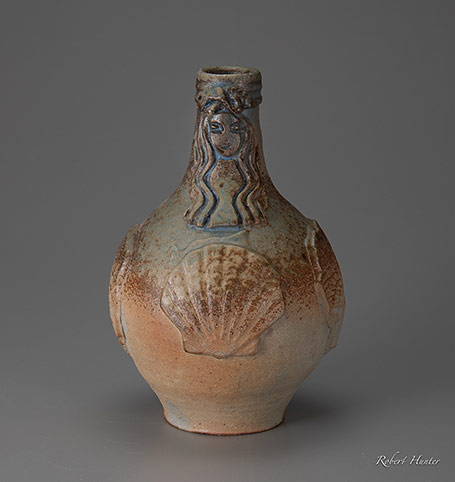 |
Delft Skull 2012 V&A Residency
Royall collection
Tin glazed Slip Cast porcelain with cobalt overglaze decoration and hand built indigenous London clay.
The imagery on this piece is taken from an 18th century English delft puzzle jug in the V&A’s collection. By using a thicker consistency of glaze and high firing temperature the once articulated hand painted cobalt decoration and inscription became a transformation of the imagery that flows and moves within the contours of the porcelain skull. !7th century British and European potters unable to recreate the technology needed to produce white high fired porcelain developed what has become known as delftware. A tin opacified glaze to coat coarse earthenware creating a bright white smooth surface. The white tin glaze decorated with cobalt blue slip created the illusion of the exotic blue and white Chinese porcelains so highly prized by monarchs of Europe and Britain. Delft Skull sits atop a piece of the London earth of this history and speaks to the act of imitation and the art of transformation.
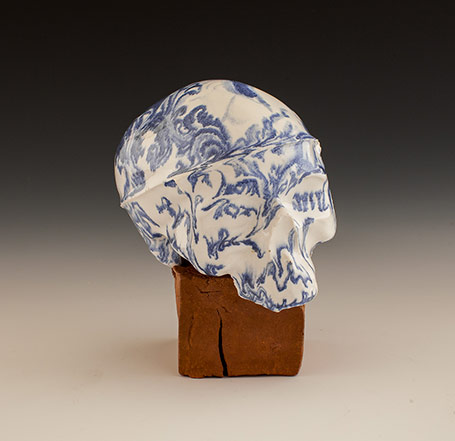 |
See V&A films
Michelle Erickson and London’s Indigenous Clays
How it was made: A Puzzle Jug by Michelle Erickson
Pilgrim Flask
Royall collection
Date: 2019
Dimensions: H 29” W 15” D 8” (base depth)
Photo Credit Robert Hunter
Courtesy of the artist
Material: Thrown cast and handbuilt NC indigenous stoneware and porcelain
Indigenous clays, wood-fired stoneware, old growth
walnut, and driftwood in collaboration with Gordon Wilkins, maker of the lid and base.
The walnut is from the site of an 18th century colonial plantation Carter’s Grove on the James River in Williamsburg, VA. The driftwood came from the prehistoric shoreline littered with fossilized shells. The site of Carter's grove was an ancient
homesite to Indigenous people for millennia and also home
to the 1620 colonial site Martin’s Hundred with the earliest colonial American pottery. In that way, the material and collaboration are connected on many levels. Gordon Wilkins has done much of the master woodwork for an extensive 5-year restoration of the house and out buildings.
Pilgrim Flask is from the series Ply-MYTH created during the exhibition project Another Crossing marking the 400th anniversary of the Mayflower crossing the Atlantic in 1620. The Protestant pilgrimage to escape religious persecution in Britain and Europe landed in Patuxet, the ancient home of the Wampanoag people.
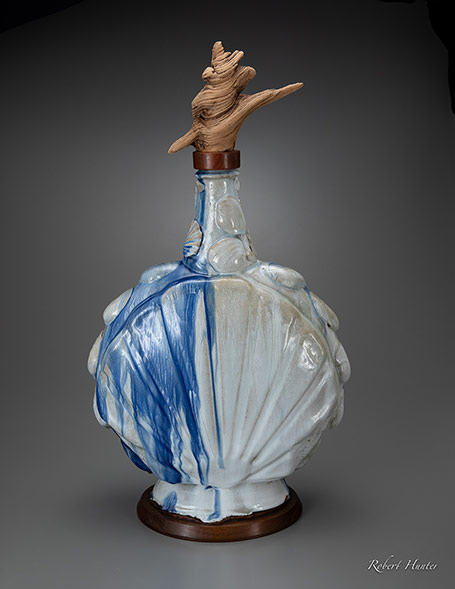 |
Our mandate from the project curator Glenn Adamson was to create work using 17th-century technology as much as possible, while exploring topics of immigration, religious persecution, invasion, displacement, disease, and genocide through a 21st-century lens. Realities generally not included in the story of the first Thanksgiving.
Pilgrim Flask incorporates a Shell gas station sign, scallop shell was worn as a badge of Christian Pilgrimage and Quahog, the shell the material used to create Wampum by Indigenous peoples for centuries. Each shell represents significant meaning to the respective cultures but both represent the natural world whose imperilment in the 21st century threatens us all.
Tea Koi 2005
Royall collection
H 9”
Thrown hand modeled and cast black and white earthenware and porcelain with hand painted colored and gold enamel.
The eighteenth century is distinguished by diverse ceramic styles, materials and innovations created chiefly by the Staffordshire ceramics industries. Influences from China can be found in the period’s architecture, textiles, ceramics, and most prevalent, in the taking of tea. Erickson’s Tea Koi celebrates the meeting of East and West with technical virtuosity combining creamware, black earthenware and porcelain to capture the whimsy and exoticism in eighteenth century Staffordshire ceramic chinoiserie.
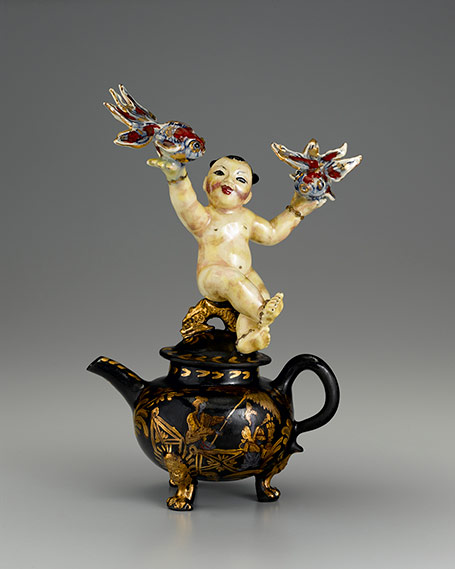 |
Ale Bottle
Price: POR
Date: 2019
H 10 ¼ W 6” Base 31/4”
Materials: Thrown sprigmolded and woodfired indigenous VA clay with 18th century bottle glass
Photo Credit: Robert Hunter
Ale Bottle references an 18th century English salt glazed stoneware bottle excavated on the colonial plantation site of Carter’s Grove in Williamsburg Virginia. The archeological bottle is embossed with the name of the plantation owner, Burwell. The 18th century bottle and it’s context embody colonialism in that Nathaniel Burwell most certainly would have an enslaved African workforce. This inspired my contemporary series of ale bottles connecting slavery and the abolition movement to 21st century institutional racism and the call for social justice.
Ale Bottle, made with clay dug on the site of Carter’s Grove is embossed with the word HUMANITY. The impression is molded directly from a 19th century abolitionist iron tobacco box depicting in relief and enslaved African figure kneeling above the outcry HUMANITY. Ale Bottle uses the material of place and artifacts of time to describe the legacy of colonialism in the 21st century. A fragment of 18th century wine bottle glass placed above the raised label and subjected to woodfired stoneware temperatures creates the glass streak that runs across it’s form.
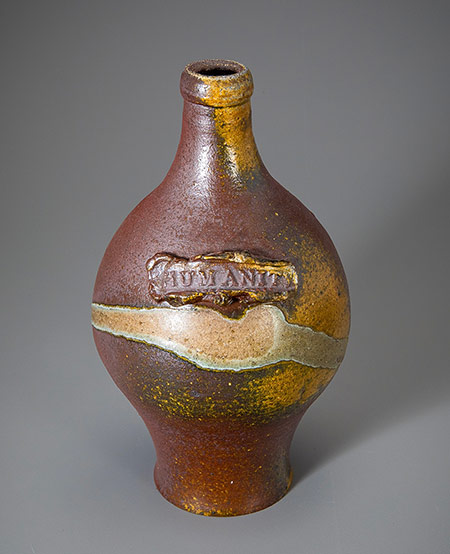 |
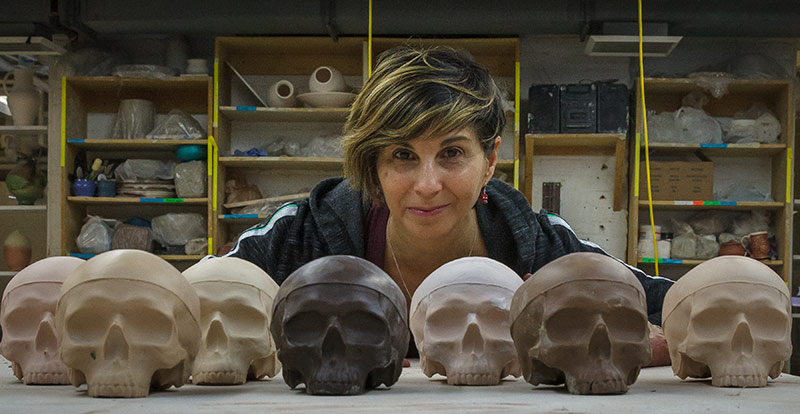 |
Double Skull Am I Not series
Price: POR
H 10” L 14” D 8.5”
2017
Thrown slipcast and handbuilt porcelain, black porcelain and indigenous Virginia clays. Woodfired stoneware.
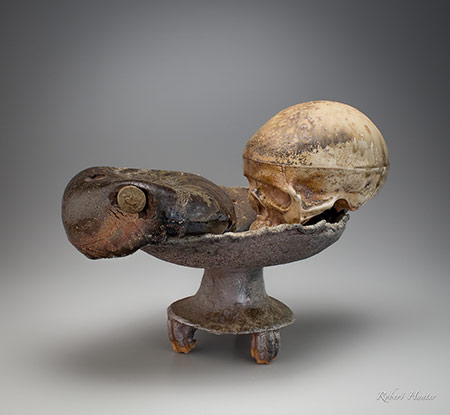 |
Green Squirrel & 2nd Amendment Squirrel
Royall collection
2014
H: 8”
Indigenous Clay copper green gaze press molded and hand built
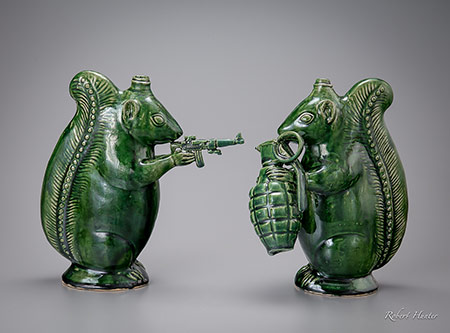 |
These animal bottles are the subject of a ‘green army’ series derived from my work Making a Moravian Squirrel Bottle published in Ceramics In America 2009 co-authored with editor Robert Hunter. This project in reverse archeology examines the figural bottles made by the North Carolina Moravian Potters in the 18th century. The characteristic green glazed squirrels inspired my modern interpretation to address environmental issues of fossil fuel dependence and the cultural epidemic of gun violence in America. The “Animal Farm” twist as 21st century satire turns the tables between man and the natural world and brings the arcane originals whose purpose had been lost to time into a contemporary dialogue.
HB2 Ring Bottle
reverse
Price: POR
Date: 2016
H16”
Materials: Thrown, and hand built wood fired salt glazed stoneware.
Indigenous ‘Catawba’ clay; fired in NC Pottery Center groundhog kiln.
While artist in residence at STARworks in summer 2016 I produced a body of work to be finished in the wood fired salt glaze stoneware kiln at the North Carolina Pottery Center. Taking advantage of the resource of Starworks indigenous clays I focused on ‘Catawba Valley’ clay straight out of the ground to experiment with jug forms. Beginning in the late16th century German salt glaze stoneware jugs were the cargo of Dutch and Portuguese trade ships bound for the colonies and archeological examples are found in the earliest colonial contexts including the settlement at Jamestown VA. In Yorktown VA archeology revealed the site of a rare salt glaze stoneware manufacture dating to1720. Dubbed the ‘Poor Potter of Yorktown” Willaim Rogers pottery produced wares that paralleled London and Fulham and were distributed illegally up and down the east coast from Philadelphia to Florida.
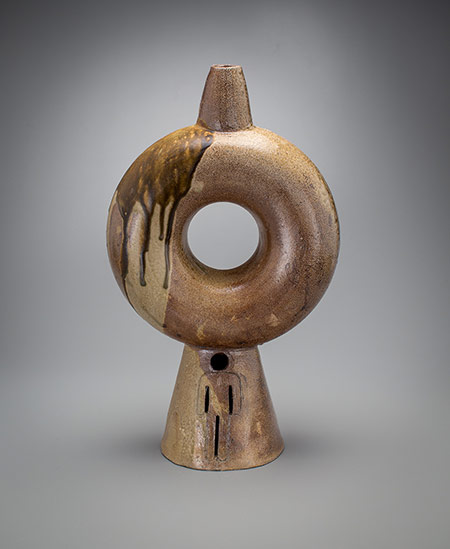 |
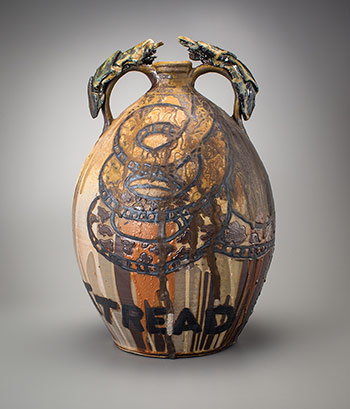 |
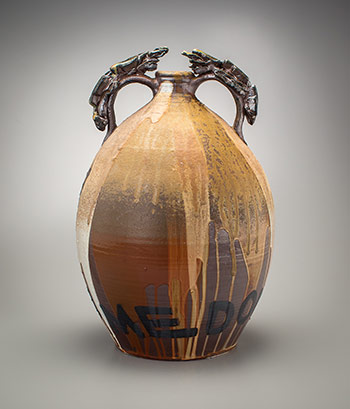 |
DON’T TREAD ON ME |
|
Wild Tweets
From the Exhibition Project Wild Porcelain Fine arts Museums of San Francisco Legion of Honor
Price: POR
2021
H 8 in.
High temperature wood-fired indigenous NC porcelain
Exhibition: Wild Porcelain The Bowels Porcelain Gallery, Legion of Honor, Fine Arts Museums of San Francisco
Photo Credit Robert Hunter
Inspired by the Chelsea porcelain tureen in the form of two nesting pigeons in The Bowles Porcelain Gallery (2004.57.3a-b), these 21st cenury figures depict ‘Larry the Bird’, the logo of social media platform Twitter.
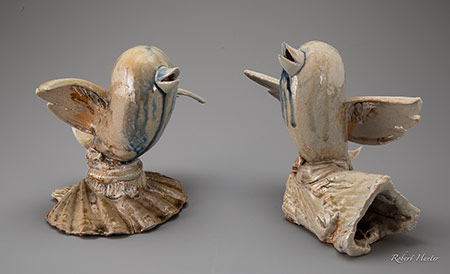 |
Bullet Tureen
From the Exhibition Project Wild Porcelain Fine arts Museums of San Francisco Legion of Honor
Price: POR
Date: 2021
Medium: Thrown, hand-modeled, and slip-cast porcelain, 3D printing Dimensions:
Overall: 8 x 5 in. (20.3 x 12.7 cm). 4)
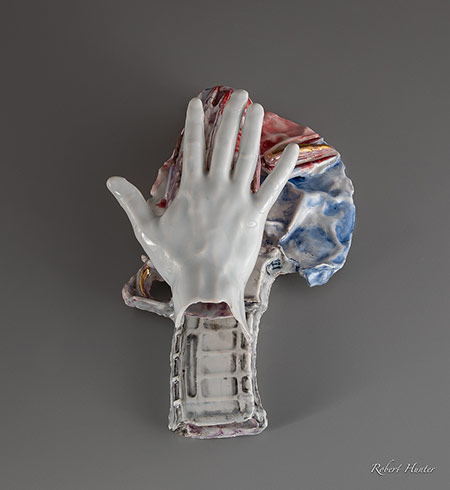 |
Bullet Tureen or Assault Server references and 18th century Chelsea porcelain asparagus server in the Bowles Collection and was created for my solo exhibition project Wild Porcelain at the Fine Arts Museum of San Francisco’s Legion of Honor. I reimagined the intimate scale and domestic function of vessels in the Bowles Porcelain collection to focus on gun violence, fossil fuel geopolitics and the undue corporate power and influence of big tech that have found their way into our most private spaces our homes our hearts and our minds. In Bullet Box the function scale and processes used to create the 18th century original are transformed into life casts assault weapon cartridges and munitions to decry the terrorism of gun violence in America. The box impressed from layers of bullets recreated a serving piece used in social and personal settings with family friends into a porcelain protest against GOP political activism that allows and legislatively promotes the unfettered access to guns and munitions that brings this uniquely American form of gun terrorism into every aspect of our daily lives.
Red White and Blue Pickle
Price:POR
Title: Sharks tooth Saggar
Date: 2017
Dimensions: Red White & Blue Pickle H 6.25” W and D 9”
Dimensions Saggar H 6.5” Dia 11”
Photo Credit: Robert Hunter
Courtesy of Artist
Material: High temperature woodfired Porcelain and indigenous clay, thrown, Slipcast, sprig molded and handbuilt with natural shells and sharks teeth.
Michelle’s seminal work in reverse engineering the historically significant American porcelain sweetmeat was first published in the article Making a Bonnin and Morris Pickle Stand with coauthor Robert Hunter in Ceramics In America 2007. This issue of the journal entirely devoted to the subject of the first American porcelain factory, operating in the burgeoning seat of revolution from1770 -1772, is the companion publication for the 2008 landmark exhibition The Art of Bonnin and Morris. The exhibition featured the 19 known pieces from the American Porcelain Manufactory that were brought together for the first time at the Philadelphia Museum of Art.
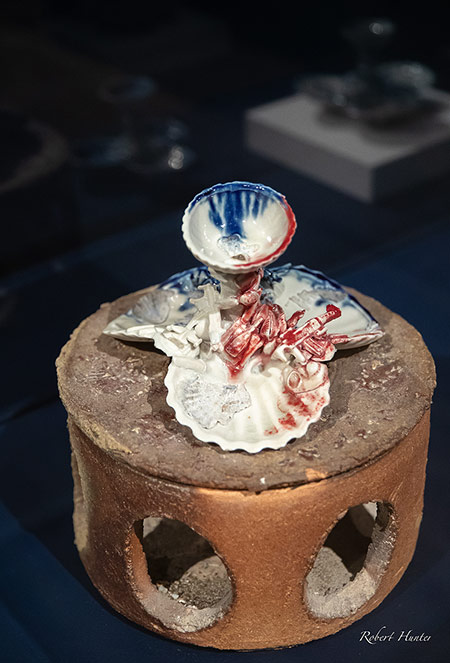 |
Red White & Blue Pickle incorporates casts of toy weapons of war off the shelves of Walmart and Target cast into porcelain. Tiny tanks guns and planes are intermixed with natural shells to create the construct of its 18th-century predecessor, the Bonnin and Morris Pickle Stand. The cobalt blue edging of the originals is replaced with red white and blue glazes brought to extreme temperatures in a woodfired stoneware kiln. The porcelain stand was fired within the large stoneware saggar. Saggars are course clay vessels used to contain and stack small and fragile wares in the kiln. The vented containers were used historically to protect delicate wares from the extreme heat and ash and carbon in the kilns atmosphere. Erickson’s Sharks Tooth Saggar has oversized vents to expose the piece visually and environmentally. The course clay is impressed with sharks teeth and Fossilized shell and coral were used to support the vulnerable porcelain stand during the 5 day high temperature wood firing. The dishes are scarred with ghost impressions of the natural shell seared into the glaze and the piece itself connects geopolitics of conflict and fossil fuel.
Fly Knit Dragon Ewer
Price: POR
Date: 2015
H 10” L 12”
Materials: Hand built sprig molded porcelain and black earthenware.
Inspired by an 18th century Vauxhall porcelain ewer from the V&A collection
Erickson’s Fly Dragon series began in collaboration with Nike 2012 Olympic Track and Field Innovation during her tenure as artist in residence at the V&A in 2012. The series of pieces correlate the 18th century English pottery industry with global design giant Nike to speak to the transference of culture through design in the ceramic medium. Experimenting with ‘extreme design’ in form pattern and color Fly Knit Dragon Ewer correlates The piece is hand built using silicon sprig molds from 2012 Olympic trainers provided by Nike’s 2012 Olympic Track and Field Innovation. Life castings that include octopi from Billingsgate Fish Market, and tourist ketch of London’s landmarks and the ‘London Eye’ base surrounded by a sheared tire ‘tread. The trademark characters Made In China elude to the globalization of 21st century industries roots in colonialism.
The links here are included in the text above and link to related postings from my ongoing blog ME@V&A
http://michelleericksonceramics.blogspot.com
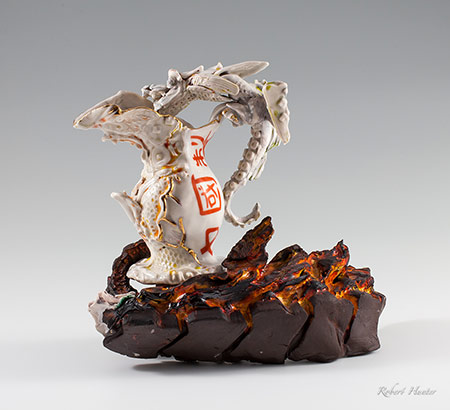 |
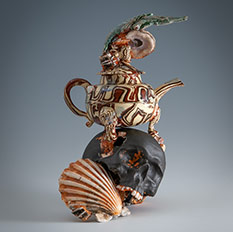 |
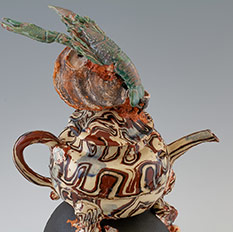 |
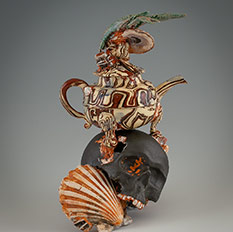 |
|
Deepwater Teapot | ||
Artifacts will feature the ceramics of artist Michelle Erickson in the setting of Try-me the private art space that houses The Modern and Contemporary Art Collection of Pamela K. and William A. Royall Jr. The exhibition will be on view March 20-23 in conjunction with NCECA 2024.
Please visit Michelle Erickson's Group show, Our America/Whose America? at the Valentine in Richmond, Virginia. On view February 21st.
